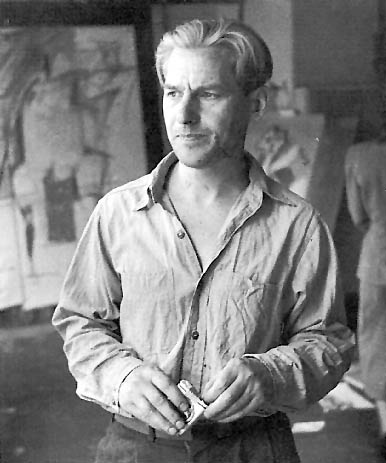Willem De Kooning (1904-1997) He is considered to be the greatest representative of surrealism for his pictorial creations of dreamlike Willem De Kooning (1904-1997)was born on April 24, 1904, Netherlands. Driven by an acutely perceptive mind, a strong work ethic, and persistent self doubt – coupled with the determination to achieve – the charismatic de Kooning became one of America’s and the twentieth century’s most influential artists.
Willem De Kooning (1904-1997) He is considered to be the greatest representative of surrealism for his pictorial creations of dreamlike Willem De Kooning (1904-1997)was born on April 24, 1904, Netherlands. Driven by an acutely perceptive mind, a strong work ethic, and persistent self doubt – coupled with the determination to achieve – the charismatic de Kooning became one of America’s and the twentieth century’s most influential artists.
Showing an interest in art from an early age, de Kooning enrolled in night school at the prestigious Rotterdam Academy of Fine Arts and Techniques (Academie van Beeldende Kunsten en Technische Wetenschappen te Rotterdam), which was renamed in his honor in 1998 as the Willem de Kooning Academie. After briefly working as a house painter, he established himself as a commercial artist and became immersed in his own painting and the New York art world.
By the late forties and early fifties, de Kooning and his New York contemporaries, including Jackson Pollock, Franz Kline, Robert Motherwell, Adolph Gottlieb, Ad Reinhardt, Barnett Newman and Mark Rothko, became notorious for rejecting the accepted stylistic norms such as Regionalism, Surrealism and Cubism by dissolving the relationship between foreground and background and using paint to create emotive, abstract gestures. This movement was variously labeled “Action Painting,” “Abstract Expressionism” or simply the “New York School.”
De Kooning became known as an “artist’s artist” among his peers in New York and then gained critical acclaim in 1948 with his first one-man exhibition held at Charles Egan Gallery, at the age of forty-four. In 1951, de Kooning made one of his first major sales when he received the Logan Medal and Purchase Prize from the Art Institute of Chicago for his grand-scale abstraction, Excavation (1950). This is arguably one of the most important paintings of the twentieth century.
De Kooning’s dramatic rise to prominence between 1948 and 1953 was only the first act in a remarkable artistic career. While many of his contemporaries developed a mature “signature style,” de Kooning’s inquisitive spirit did not allow such constraint
By the late fifties, he had moved from women, to women in landscapes, to what seemed to be a return to “pure” abstraction, with works respectively referred to as “Urban,” “Parkway” and “Pastoral” landscapes; yet he never completely left the world of actual objects for pure abstraction.
On a brief trip to Italy in 1969, after encountering a sculptor friend, Herzl Emmanuel, de Kooning produced thirteen small figures in clay, which were editioned in bronze. In the early seventies he explored both sculpture and lithography, producing a sizable body of work while continuing to paint and draw.
Succumbing to the affects of old age and dementia, de Kooning worked on his last painting in 1991 and passed away in 1997 at the age of 92, after an extraordinarily long, rich and successful career.
De Kooning was awarded many honors in his lifetime, including The Presidential Medal of Freedom in 1964. His works have been included in thousands of exhibitions and are in the permanent collections of many of the finest art institutions abroad, including the Stedelijk Museum, Amsterdam; Tate Modern, London; and the National Gallery of Australia, Canberra; and in America such as The Museum of Modern Art, New York; The Metropolitan Museum of Art, New York; the Art Institute of Chicago; the Smithsonian Institution’s Hirshhorn Museum & Sculpture Garden, Washington D.C.; and the National Gallery of Art, Washington, D.C.
